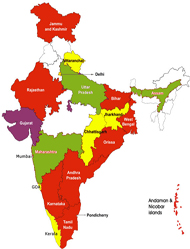
Renewal of Vows/Royal Weddings
Are you a wedding planner or travel agent or just looking for some ideas for a Royal Indian wedding at one of the beautiful forts, palaces or luxury hotels in India? We have a wedding product which has got all the ingredients of a true and elegant 'INDIAN' wedding. Our sales and operations team has meticulously worked with one of our partners to design this product. The product showcases the 'Renewal of Vows' in Delhi(Church blessing) and Jaipur with a little trip in between to Agra to get those beautiful pictures in the 'White gown' and 'TAJ MAHAL' as your background….It will surely be the perfect setting for your pearl, Ruby or Diamond wedding anniversary!
The Indian culture celebrates marriage as a sacrament (Sanskara), a rite enabling two individuals to start their journey in life together. In a Hindu wedding, the multiplicity of creation becomes possible when spirit (Purush) unites with matter (Prakritti). The Hindu wedding lays emphasis on three essential values: happiness, harmony and growth. Wedding traditions vary across religion, caste, ethnicity, language and region. Traditional Indian weddings are generally structured into pre-wedding ceremonies, wedding day ceremonies as:
Jaimala (Exchange of Garlands) : The couple exchange garlands as a gesture of acceptance of one another and a pledge to respect one another as partners.
Havan (Lighting of the Sacred Fire) : The couple invokes Agni, the god of Fire, to witness their commitment to each other. Crushed sandalwood, herbs, sugar rice and oil are offered to the ceremonial fire.
Kanyadan (Giving Away of the Bride) : The father of the bride places her hand in the groom's hand requesting him to accept her as an equal partner. The concept behind Kanyadan is that the bride is a form of the goddess Lamxi and the groom is Lord Narayana. The parents are facilitating their union.
Saptapardi (Seven Steps Together) : The bride and groom walk seven steps together to signify the beginning of their journey through life. Each step represents a marital vow:
First step: To respect and honor each other
Second step: To share each other's joy and sorrow
Third step: To trust and be loyal to each other
Fourth step: To cultivate appreciation for knowledge, values, sacrifice and service
Fifth step: To reconfirm their vow of purity, love, family, duties and spiritual growth
Sixth step: To follow principles of Dharma (righteousness)
Seventh step: To nurture an eternal bond of friendship and love
Sindhoor (Red Powder) : The groom applies a small dot of vermilion, a powdered red lead, to the bride's forehead and welcomes her as his partner for life. It is applied for the first time to a woman during the marriage ceremony when the bridegroom himself adorns her with it. Mangalasutra (Thread of Goodwill) : A necklace worn specifically by married women as a symbol of their marriage.





